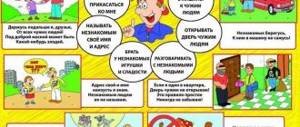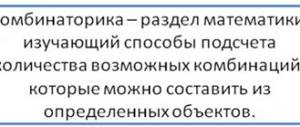Lesson summary No. 26 (3) on life safety, grade 6 04/03/20
Lesson topic:
Hardening the body. Hardening methods.
Target:
show the importance of hardening for the whole organism.
Tasks:
Educational:
study the rules and methods of hardening procedures, consider the rules for observing temperature parameters.
Corrective:
correction of consciousness and behavior in relation to one’s health.
Educational:
cultivate interest in maintaining a healthy lifestyle, love for physical education and sports.
Lesson type:
lesson on introducing new material.
Equipment:
board, notebooks, pens, illustration cards.
During the classes:
| Lesson steps | Teacher activities | Student activities |
| I Preparatory stage | ||
| Org. Nan moment. | So guys, pay attention! After all, the bell has already rung. Sit back, let's start the lesson soon. • Checking readiness for the lesson. • Psychological mood for the lesson. • Date parsing (date, day of the week, month, which one, time of year). • Lesson of what, which one. | • greet the teacher. • report from the duty officer. • check their readiness for the lesson. • give answers. |
| Motivation for learning activities. Updating knowledge. • Checking homework. • Communicate the topic and purpose of the lesson. | - Dear Guys! Today in class we will work hard. I'm glad that we all got together again. Everyone is healthy and looking good. I enjoy looking at your pretty faces. We have an interesting lesson ahead. We will learn a lot of new things in today's lesson: be active, attentive, and eagerly absorb knowledge that will be useful to you in later life. Guys! Let's remember the topic of the last lesson, “Ways to improve physical fitness.” (frontal survey of students) The epigraph for our lesson can be lines from a funny song: “I’m not afraid of frost, nor heat, Even doctors are surprised, Why am I not sick, Why am I healthier than all the guys from our yard. Because it’s early in the morning, I’m not too lazy to do gymnastics, Because I douse myself with tap water every day...” Today in the lesson we will talk about hardening the human body. You will learn: what is hardening? What is it for? Get acquainted with the basic means and rules of hardening, find out what activities it is important to combine hardening with. It’s not without reason that they say: “If you want to be healthy, toughen up!” We open the notebooks, write down the date, class work and topic of the lesson. Don't forget to skip one cell between entries. | They give answers. Write it down in notebooks. |
| II Main stage | ||
| Learning new material | You often hear the expression: “hardened like steel,” which means very strong. It’s good when a person is also seasoned. This means that he catches colds less often, gets sick less often, i.e. has good health, appetite, such a person is calm, balanced, cheerful, cheerful. Differs in high efficiency. Hardening is an increase in the body’s resistance to cold, heat, wind, and sudden changes in temperature. Now guess the riddles: Those who are friends with me rarely need a doctor. The skin will darken and you will get healthier. (the sun.) There is an invisible person: She doesn’t ask to come into the house, But she runs ahead of people, in a hurry. (air.) Running down the mountain without difficulty, It thunders like thunder. On a frosty day it is hard - you can even cut it with an axe! Heat it up and then it will fly to the heavens. Now you will answer me yourself: Her name is………..(water.) The best means of hardening are the natural forces of nature: the sun, air and water. The essence of hardening is that under the influence of the natural forces of nature - air, sunlight and water - the body adapts to easily tolerate weather changes. Heat and cold. Hardened people are distinguished by their flourishing appearance and high resistance to colds, while for unhardened people even a slight cooling of the body causes a runny nose, cough, etc. -What should you do to harden your body? You should start any hardening only after visiting and checking with a doctor, since hardening is a training, not a treatment, and such procedures may be contraindicated for people with illnesses and weak immune systems. Sun hardening (sunbathing) When sunbathing, you should follow simple rules. Start sunbathing in the lacy shade of the trees for 3 - 4 minutes, with a break of 10 minutes. Every day, add 2 - 3 minutes of exposure to the sun. Alternation is very useful: a few minutes in the sun, a few minutes in the shade. You should sunbathe in the morning and evening hours, exposing your back, chest, and sides alternately to the sun's rays. And don’t forget, when going out into the sun, put a panama hat or scarf on your head. It happens that some guys do not tolerate the sun's rays well, then they need to be even more careful when sunbathing. And if the doctor forbade sunbathing altogether, there is no need to be discouraged. You can take air baths in warm cloudy weather. Air hardening (air baths) Air - fresh, clean - is useful for everyone. You can take air baths in the sun and in the shade. Air baths are good during hikes when the route goes through the forest. And in general, try to move more during air baths. Air baths should be taken in places protected from the wind. It is better to start in the summer, at a temperature of +16 °; +18° . The first bath should last 2 - 4 minutes. Then increase to 20 minutes. If the temperature is +20°, double the time. You can organize a daytime nap in the fresh air in a room with open windows, on the veranda, under a canopy. In autumn, slow walking in warm clothes through the forest, river bank, or park is useful. The length of the route is up to 1 km. You can take air baths at home by lowering the temperature to +18°; +20°. It’s very good to create a draft, but you can’t be in a draft yourself. It is necessary to constantly monitor the cleanliness of the air and be sure to ventilate the room before going to bed. Hardening with water (rubbing, dousing, showering, swimming in open reservoirs) The main healing properties of water: helps the skin secrete harmful metabolic products in the body (when wiping) and cleanses from pathogenic microbes (when swimming, taking baths). Hardening with water can begin with wiping or dousing. For the first douche, the water temperature should be +32°; +33°. Every other day, lower the temperature by 1°. After dousing, rub your body well. How is rubbing done? First prepare the water. Wet a mitten or towel in water and quickly wipe your chest, stomach, and back with it. Then rub yourself until red with a dry towel. Remember: reduce the water temperature gradually. But if you start to harden, do these procedures every day, otherwise you won’t get a good result. The water temperature can be reduced to +20°. A contrast shower is beneficial for the body, that is, alternating dousing with warm and cold water. Stand in a warm shower for 1.5 minutes, then douse yourself with cool water. Before hardening, be sure to consult with your parents about what water temperature is best to start with. In summer, swimming in the river or sea strengthens your health. | The teachers are listening. They give answers. Write it down in notebooks. |
| Fizminutka | We correct your posture. We bend our backs together. We bent to the right, to the left, and reached our toes. Shoulders up, back and down. Smile and sit down! | Get up and do the exercise. |
| Consolidation of the studied material. | To obtain positive results from the use of hardening procedures, the following rules (principles) must be observed: 1. Gradual increase in the dosage of the irritant. It is better to start hardening in the summer. 2. The sequence of application of hardening procedures. You can move on to water procedures and sunbathing after you have gotten used to air baths. First, rubbing, then dousing and swimming in open water. 3. Regularity of the procedures started. Hardening procedures must not be interrupted. With long breaks in hardening, its effect is reduced or lost completely. 4. Complexity. Hardening procedures should be combined with games and walks in the fresh air, morning exercises, room ventilation, and physical work. 5. Taking into account individual characteristics. When choosing the dosage and forms of hardening procedures, various individual characteristics of a person are taken into account - age, health status, and other factors. This is explained by the fact that the body’s reaction to hardening procedures varies from person to person. In addition, you need to know that you cannot immediately become hardened. Hardening is a long process. As a result, the central nervous system, cardiovascular, respiratory and other systems of the body are strengthened. To better remember the rules of hardening procedures, you and I will draw up a reminder and write it down in a notebook. | Write it down in notebooks. Rules for hardening procedures: 1. Gradual. 2. Consistency. 3. Regularity. 4.Complexity. 5.Individuality. |
| Homework | Learn the “Rules of hardening procedures.” Draw pictures on the topic: “Hardening.” | The teachers are listening. |
| III Final stage | ||
| Summing up the lesson | — What was the topic of the lesson? — Is body hardening available to everyone? —What is the best friend of someone who decides to strengthen himself? -What rules should be followed when hardening? Students' work in class is assessed. | Summing up. They give answers. |
| Reflection | — Every person should take care of their health. After all, no one will take care of you better than yourself. Let's say the magic words together: I will save my health, I will help myself! - Soon the bell will ring and the lesson will end! | |
Actions in case of accidents and disasters
Open a list of all articles from the section
Aviation accidents: types, causes and what to do
Causes and types of accidents in air transport. What to do in case of emergency landing on water, during turbulence, decompression, fire or hard landing.
Hydrodynamic accidents: causes and consequences
What are the causes of hydrodynamic accidents? Consequences of hydrodynamic accidents examples. Actions after a hydrodynamic accident.
Safety rules in public transport
Safety in ground urban transport. Safety in the subway. How to protect yourself on rail transport. What to do in case of fire.
Chemical accidents and action plan for the public
Danger of accidents with the release of hazardous substances. Causes and consequences of chemical accidents. What to do and what actions to take on the street, at home, at school. Liquidation and protection in case of accidents.
Open a list of all articles from the section
Actions in case of fire or fire
Open a list of all articles from the section
Rules of conduct in case of fire: analysis of situations and action plan
Rules for safe behavior in case of fire. If you find smoke in the entrance. Fire in an educational institution. Fire in the basement. What to do in case of a fire in an elevator
Handy means for extinguishing fires
An educational article for all ages about available fire extinguishing means (fire extinguishing) and the rules for their use. Video about available extinguishing agents.
Actions of workers and personnel upon detection of a fire
The procedure for workers and personnel when a fire is detected in an enterprise building. What should the head of the organization do in the event of a fire?
Smoke in the entrance: algorithm of actions
If you smell smoke in the entrance, we will tell you what to do. How to behave correctly in this situation. Safety regulations
Open a list of all articles from the section
SAFETY RULES IN THE COMPUTER SCIENCE OFFICE
3.1. SOURCES OF HAZARD:
- electrical appliances with a supply voltage of 220 V, monitors and televisions, which can be a source of electrical injury;
- the presence of electrical appliances increases the risk of fire;
- Computer monitors and televisions are weak sources of ionizing radiation from electromagnetic, electric and magnetic static fields.
3.2. SAFETY REGULATIONS
PROHIBITED:
- work with electrical appliances that have damaged housing or insulation of connecting wires;
- make unauthorized switching of equipment connectors;
- bring and connect any equipment without permission;
- insert foreign objects into the opening of the devices;
- turn off or turn on devices without the permission of the teacher.
If turning off/on is performed, then the time interval between turning on/off and turning on/off must be at least 15 seconds.
IN THE CASE OF ELECTRIC SHOCK, YOU MUST:
- stop the current (it is best to turn off the devices urgently, since an attempt to drag the victim away can lead to electric shock to the rescuer);
- immediately report the incident to the teacher (even if at first glance everything turned out to be a slight fright);
- provide first aid if necessary.
3.3. FIRE SAFETY RULES
PROHIBITED:
- use open flame sources (matches, lighters, firecrackers, etc.);
- bring flammable substances (varnishes, paints, gunpowder, etc.) to lessons;
- use faulty electrical appliances (if a specific smell of burning insulation appears, the corresponding device must be immediately turned off and notified to the teacher);
- obstruct or block passages to escape routes and access to primary fire extinguishing means;
- extinguish fires of electrical appliances that have not been switched off with water or conventional fire extinguishers;
- involve students in putting out fires.
IN CASE OF FIRE THREAT (fire, smoke) IT IS NECESSARY:
- immediately turn off all electrical appliances, identify sources of ignition (smoke) and eliminate it with primary fire extinguishing means;
- If the initial actions to extinguish the fire within the first minutes do not produce results, students are evacuated according to the evacuation plan, an alarm is declared throughout the school, and a fire is reported.
Emergency procedures
Open a list of all articles from the section
Safety in crowds: basic rules and psychology of behavior
How to define a crowd and what types it is divided into. Safety in a crowd: rules and psychology of behavior. What to do if you find yourself in a crowd
Actions of the population during a hurricane, tornado, storm: basic order
How to survive a hurricane, storm or tornado as a person. What to do if there is a threat or during a hurricane while in a building, as well as in an open area on the street
Danger of ice: safety requirements and rules
How to behave in icy conditions. How to drive a car in icy conditions. Ice injuries and first aid
Safety rules during a thunderstorm
Rules of behavior during a thunderstorm in open areas, ponds and water, in the forest, safety precautions indoors, what to do when encountering ball lightning.
Open a list of all articles from the section









